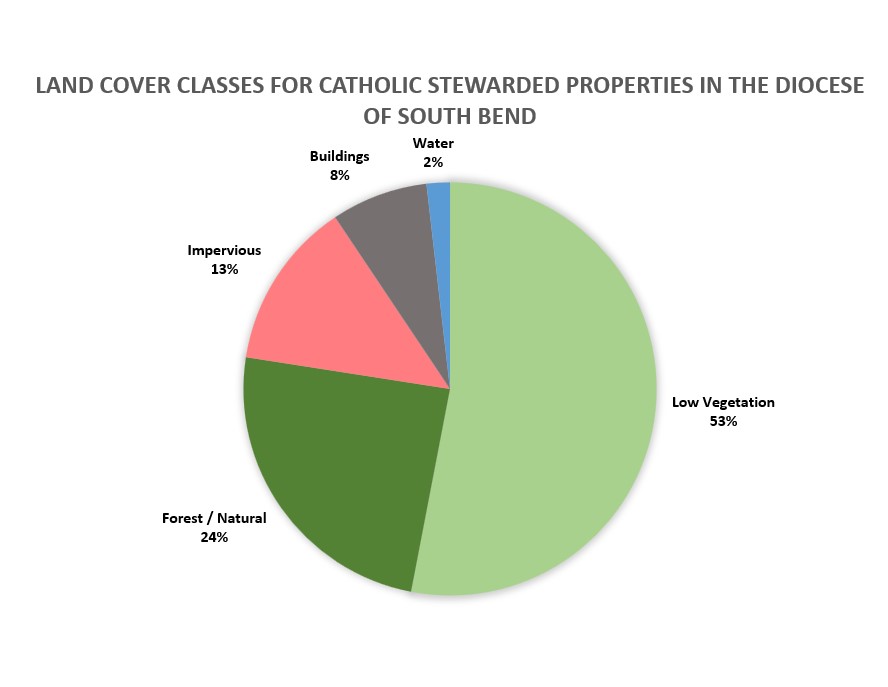This page is under construction. Stay tuned! More coming soon.
Welcome!
At the Saint Kateri Conservation Center, we believe that Catholics can lead the way in caring for our Earth and restoring biodiversity. There are more than 61 million Catholics and 17,000 Catholic parishes within the United States. Imagine if Catholics across the country worked together to renew our faith and restore our Earth!
We believe that caring for our common home should use a holistic approach, where integral ecology in partnership with indigenous knowledge and leadership is infused within Catholic communities, starting at home and with our Catholic parishes.
Catholic parishes can serve as refuges for biodiversity and climate resilience, much like an ark, where people and wildlife flourish and grow.
Our Goal: Conserve 30% of Catholic parish open land and water for the well-being of people, biodiversity, and climate resilience, through faith, rewilding, restoration, and land conservation.

Earlier this year, Irish bishops asked parishes to conserve 30% of property for pollinators, biodiversity. This request comes in response to Pope Francis’ Laudato Si, understanding that biodiversity is directly correlated to ecosystem services and resilient ecosystems for people and wildlife. While this request occurred in Ireland, parishes in the United States can also make headway in creating safe havens for biodiversity to flourish in parish communities. The Saint Kateri Center Parish Arks program provides a pathway for parishes to take the next step in achieving this goal with the help of Catholic Ecologists.

Did you know that over 50 percent of parish land is composed of lawn? It’s true. We know that restoring biodiversity can be done by converting unused lawn into wildlife habitat for both people and animals to enjoy. Converting this open space is critical to restoring our common home and the ecosystem services it provides. Parish property is the perfect place to begin, reducing the burden of maintaining unused open space and providing new opportunities for the community to recreate and read the Book of Nature. On the left, the chart shows the percentages of catholic stewarded property in a midwestern diocese by land cover type. Low Vegetation is composed of lawn, barren land, and in some cases, agriculture. While not all land can be converted, even some of it would make a difference!
- Understand: Knowledge of the place that you live and worship is important in understanding how to manage the land going forward. Indigenous peoples have managed the land and lived in harmony with creation for thousands of years. Understanding the relationship indigenous nations have with land is an important starting point to learning how to restore land to its natural state using native vegetation and practices. A good first step to understanding this history and sense of place is to use the Native Lands Mapper to see whose homelands you are on, and where they are now. Taking this one step further and engaging with indigenous people in the management of property can be fruitful for all involved.
- Assess: How much open space? Parish property often contains a lot of unused open area that could be converted to wildlife habitat. While there is always a need for some open area like gathering spaces and athletic fields, some open space is lawn that is vacant and mowed. What percent of your parish property is considered open area? How many acres of this open area would have to be converted to reach 30%? In the Diocese of South Bend, Indiana, The Saint Kateri Conservation Center is working with Notre Dame University on a pilot project to show how mapping can help Catholic landowners with campuses identify the 30% open area on their properties. Check out this app to see how it works!
- Identify: Using mapping and other tools, we can help you identify where on your parish property you can begin employing tools to convert open area to habitat for people and wildlife. Staff at the Center can help you to create plans to use open space more effectively and mapping where and how to take the specific actions listed below in #4. Email us at saintkatericenter@gmail.com to discuss tailored plans for your property.
- Conserve: With areas identified, a variety of scientific tools can be employed to conserve and restore open area. These include:
- Pollinator Habitat Installation
- Meadow Creation
- Water Management (e.g.: rain gardens)
- Large scale habitat restoration (reforestation, stream restoration, stream barrier removal, and more)
- Land Conservation/Preservation.
Many of these tools are possible through the Center’s programs. For example, the Saint Kateri Habitat Program explains how to create wildlife habitat. Our Land Trust program also assists in identifying and preserving large tracts of land.
4. Monitor: Monitoring conservation and programs is essential to success! In addition to scientific monitoring, parish communities can even monitor biodiversity on campus using techniques such as iNaturalist, a program we also offer.
5. Educate: Infuse the connection between faith and ecology within Parish School curriculum, parish ministries, and formation. Our Catholic Ecology Library can be used to create resources for this purpose.
